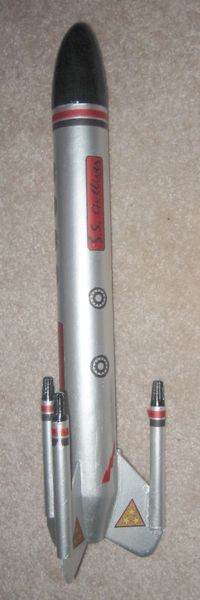Scratch S.S. Gulliver Original Design / Scratch Built
Scratch - S.S. Gulliver {Scratch}
Contributed by Clive Davis
| Manufacturer: | Scratch |

Brief:
This project started with a mailing cardboard tube that was not standard
"rocket" size. I ended up having to create my own balsa nose cone
(accomplished in a rather amateur fashion on my electric drill). I also used up
some old 10.5 mm body tubes. The S.S. Gulliver uses 18 mm motors and features a
mylar parachute.
Construction:
The parts list:
- 11" mailing Tube style Body Tube, just about the diameter of a BT-60
- balsa nose cone custom made to fit mailing tube (Big Bertha style)
- balsa for fins
- motor mount system consisting of BT-20, BT20-60 centering ring, engine block
- cardboard for shroud
- 10.5 mm body tubes, 3 quantity, cut to 3.75"
- 3 electrical wire nuts, 10.5 mm in diameter
- shock cord material
- Kevlar®
- mylar parachute
- screw eye and BB's for nose weight
- rocket sketch
The trick to this rocket is getting the motor mount to sit correctly in the body tube with about 4cm of the motor mount projecting out the back of the rocket. Before gluing this in, I test fit it with a shroud that fit snugly with the body tube to the motor mount, approximately 4 cm in length. I also made sure I tied the Kevlar® to the centering ring before gluing the assembly into the body tube.
Next, I cut the 3 fins using a hand drawn template. The fins fit flush with the bottom of the rocket and thus need to be against both the shroud and body tube. The three small body tubes are then glued to the fin tip of each fin. I epoxied the wire nuts on to the top of each 10.5mm tube. I also stuffed the bottom of each 10.5 mm tube with a mixture of yellow glue and tissue paper to fill the gaps that existed on either side of the fin.
I created my own nose cone using an electric drill and a sanding block. I drilled a hole in the bottom of the nose cone to add additional weight, in this case, some epoxy and BBs. I capped the bottom of the nose cone with more epoxy and balsa and inserted a screw eye. The center of gravity for an empty S.S. Gulliver should be 7.75" from the bottom of the motor mount assembly.
I added an elastic shock cord and a mylar parachute that I had in my extra parts box.
Finishing:
I painted the rocket silver and painted the nose cones black. I printed the
decals on 8.5" x 11" clear Avery label sheets. I designed the decal
images in Microsoft Word, hence their cheesy, poor quality. After I added the
decals, I gave the Gulliver a clear coat of lacquer. [Note:
the decals are available for
download.]
Painting the rocket was no big deal. The difficulty was getting the decals to adhere correctly to the rocket. I used a clear Avery label sheet because this is what I had. It printed rather well, but I did not seal the inkjet ink before cutting the decals free and adding them to the rocket. This meant that some of the ink began to smudge. Also, with Avery labels, they really don't like to have any extra paper visible beyond the colored portion of the "decal". Doing so will reveal a kind of grayish coat to the perimeter of each decal. I had to cut the decals as close to the edge as possible. Hence, decals with straight lines look best while decals with rounded corners or circles can look a little awkward.
Flight:
I have flown this bird half a dozen times, all on either B6-4s or C6-5s. It is
a very steady performer with nice flights. The altitude is respectable, but it
certainly will not break any NAR records. All of my recoveries have been
perfect except for my last flight in which the mylar parachute ripped. It still
came down smoothly and gracefully, although the shroud line ripped into the
side of the parachute so much that the parachute needs to be replaced.
Recovery:
This wide-neck bird is easy to prep. Plenty of room for dog barf an parachute.
No problems with parachute deployment either.
Summary:
This was a fun build for me. It was a first in many ways:
- First homemade nose cone
- First shroud that mated nicely to body tube
- First attempt at creating decals
This was a positive experience, and it is a nice flyer.
Sponsored Ads
 |
 |











